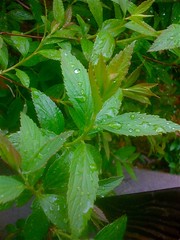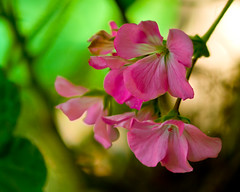
Wednesday, April 22, 2009

Sunday, April 19, 2009
iPhone Experimentation

My brand-spanking-new Sigma 18-50mm f2.8 is away at Sigma getting fixed, and I've been jonesing for it. So yesterday evening I was out in the yard with the daughter, and I snapped a couple of images with the iPhone. This made me think about the whole gear vs talent debate. Is it really the hardware? Are good images actually good images by dint of the proper exposure and sharpness and color reproduction? Or is there some ability, talent, training, or what-have-you that translates into "photographer"?
 reasonable manner proclaim that it is not art.
reasonable manner proclaim that it is not art. pixels, but a record of the intent - however whimsical - of the photographer, whether that photographer is Robert Mapplethorpe, Leonard Nimoy, or your old aunt Jeanie. That image is art. Good art, bad art, nonsensical art, ridiculous art - but it is art.
pixels, but a record of the intent - however whimsical - of the photographer, whether that photographer is Robert Mapplethorpe, Leonard Nimoy, or your old aunt Jeanie. That image is art. Good art, bad art, nonsensical art, ridiculous art - but it is art.Saturday, April 18, 2009
One Of Those Days
 So way back in the 80s, my wife and I went to the zoo. We were without child then, but were both animal lovers just the same, so off we went. I took my T90 and canon FD lenses along so I could shoot pictures along the way.
So way back in the 80s, my wife and I went to the zoo. We were without child then, but were both animal lovers just the same, so off we went. I took my T90 and canon FD lenses along so I could shoot pictures along the way.Monday, April 6, 2009
Little Pink Flowers

Little Pink Flowers
Originally uploaded by jstevewhite
For some reason, I have always loved taking pictures of flowers. I know I'm not alone - there are lots of such pictures to be found on Flickr. But the common nature of such images hasn't reduced my fascination one bit.
I tried for days to get this image. I know, it seems fairly simple, but the flowers are under the roof on my back porch, in shade, and I had a really hard time getting an exposure that I liked. I either had too little depth of field or too much, too little contrast or none at all, or subdued colors - for some reason, I couldn't capture the intensity of the colors.
Then I got my 100mm Macro (an old Pentax-M lens originally destined, I believe, for a dentist's office) and things came together. I finally got the right balance of contrast and color, and got the right bits in focus (I think). At least this captures fairly closely my internal representation of these little pink flowers.
Thursday, April 2, 2009
Beetle

Beetle
Originally uploaded by jstevewhite
Macro photography is probably my favorite type of photography these days. back when I was younger, it was glamor photography, but things change. Anyway, I came across this beetle - he was about 1/4 inch long - and popped off a few caps of him. I didn't even know until I got the image on my iMac that his shell was transparent. I'd have taken more pictures if I had.
This was shot with an old SMC Pentax-M 100 f4 Macro. It's an old lens that was popular with dentists, and it only does half life size. But it's contrasty and sharp and works well on my K20D. Old tech meets new and works really well.
That's one of the main reasons I chose Pentax, rather than Canon (which is what I shot, mostly, in film). I'd always loved the old SMC Pentax lenses - they had an almost Zeiss or Leitz type contrast and saturation - but I couldn't afford an LX, while A1s and even F1s were a couple hundred dollars. But nowadays, I can indulge my old fetish - and I have, with several old Pentax lovelies.
For hand held macro, I use a 'point and shoot' system. I have an ancient Vivitar 283 with the manual adjustment plug, and a Lumiquest on-flash softbox made for event photographers. The softbox nearly hangs over the end of the lens, giving me a very diffuse light source. I run the lens out to (usually) maximum magnification. I set the K20D for "Catch-in-focus" (where it fires the shutter when the sensor detects something is in focus), and I walk up to a test subject until the shutter triggers. I adjust flash power, test again, adjust flash power - then delete all the test images and head out to the garden. By now, I know that anything that's in focus will be properly exposed.
You still have to pick your target's pose properly. Because of the extremely short distances involved, something a little closer to the lens can get significantly more exposure. Also, if you're not shooting in bright - and I mean BRIGHT - sunlight, you can get the "flash look" where the background is pitch black. So if you want to do this hand-held macro work, pick your "stage" carefully.
You can spend (literally) hours walking around your back yard photographing tiny stuff. Give it a shot, it's fun.
Wednesday, April 1, 2009
Reflections of Mortality

Reflections of Mortality
Originally uploaded by jstevewhite
I hate spiders. A LOT. I hate them the way slugs hate salt. And of all the spiders I'm ever likely to meet, I hate Loxosceles Reclusa the most. They're just evil. You can tell in this picture just how evil they are.
The discovery of a big mother brown in our bathtub led me to cruising the internet looking for information on this beauty. Turns out the only way to be SURE is to count their eyes. I have a couple of images that allow me to do so, and she has six, in just the right places. Anyway, after spending way too much time on sites about spiders that had .edu in the URL, I learned more about browns that I ever wanted to know. Including lovely trivia like, they can live in a sealed box with no food or water for over a year. That's when I decided they're evil.
The sites often question the brown's reputation for producing disgustingly damaging bites, but there was enough waffling that I'm not ready to discount their bite as potentially SUCKING out loud.
This one got stuck in a plastic bowl that I had left under the toilet's shut off valve after replacing it, just in case it dripped. When I came back upstairs and checked for drips a couple days later, I found this scene. Her body is 3/4" long, and the long leg span you see there approaches three inches. Well, it did. I followed this up by flushing her and her dinner down the toilet.
Because I'm so scared of them, I have to take their pictures. It's a compulsion. I'm not sure why, and paging through my photos gives me the willies sometimes. But I kinda liked the way this image turned out, anyway.